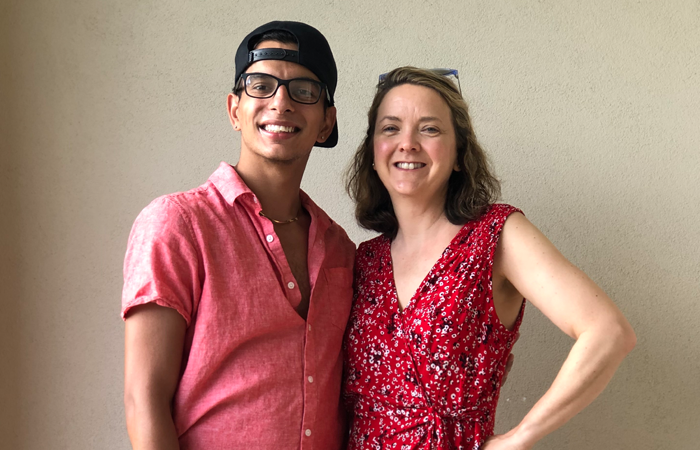I thought the assignment was appalling. My daughter had to analyze the physical attributes of our family to look for genetic links.
Clearly intended for a two-parent family with birth children, the assignment was deeply insensitive to non-traditional families. But despite my outrage, I didn’t contact the teacher or the school.
Why? Because it was a middle-school biology project. And by the time our kids reach middle school, they need to be handling school assignments mostly on their own. We no longer zip their jackets or check their math homework. And if we’ve taught them how to respond to adoption-related school assignments, we can watch from the sidelines as they do it for themselves.
Whether it’s a family tree or a personal timeline, a unit on ethnic traditions or a lesson on genetics, teachers often query children about their origins and family make-up, asking for information that can be intensely personal or missing altogether.
For my friend, Laura, the first challenge came even before her daughter started preschool. Parents were asked to send in a baby picture for a classroom display called “Look How Much We’ve Grown.” But Laura didn’t have baby photos — she had adopted her daughter at age three.
Welcome to school
In early elementary school, family is a major focus of the curriculum. Your child may be asked to write “All About Me,” to draw pictures of his family, or to interview you about his birth. He may even have a chance to be “Star of the Week,” in which he gets to talk about himself and his family.
Before we know it, perhaps even before we’ve had a good adoption chat with our daughter or son, other children will be asking questions. When my daughter was five, her turn as classroom star unexpectedly became a lengthy discussion of adoption when another student asked, “Where’s your father?”
When it was Hope Goodrich’s turn to present her family to her first-grade class, every hand in the room went up asking her to explain what she meant by “adopted.” “Mom,” Hope reported afterward, “The other kids thought I was ‘a doctor.'”
To prepare our children for school, we’ll need to talk about adoption long before they enter kindergarten. Kids will do best if they feel comfortable explaining the basics of adoption to peers by the time they start school. Try role-playing responses to commonly asked questions.
Another option, and one that not all parents feel comfortable with, is to meet with the teacher before the school year begins, to find out what’s ahead. Offer to be a resource about adoption for the school staff, provide adoption materials to the school library, or read a book about adoption in the classroom. You’ll want to make sure your child is comfortable with your chosen strategies before you make an appearance in the classroom.
If you’re thinking of making an adoption presentation at your child’s school, don’t wait too long. At ages five and six, most children welcome their moms in the classroom. They’re happy for you to bring in a storybook about adoption, or share a cultural celebration, and are generally pleased to be the special center of attention.
Around age seven, however, children become more self-conscious about differences, and realize that adoption isn’t an experience shared by all.
At elementary school
In the third and fourth grades, students are often asked to create family trees and autobiographical timelines, assignments that ask for information that may be missing, incomplete, or different from their friends’. At about the same time, children are beginning to understand and to think about the families and cultures they left behind.
When an assignment is insensitive, it’s tempting to rush in and demand that it be dropped. But that’s not necessarily the best solution, says Patty Cogen, a Seattle adoption therapist. First, find out whether your child would like you to intervene on her behalf or whether she’d prefer your help to come up with a solution.
Some children are very troubled by such assignments; others merely want help getting the project done. Some kids prefer parental intervention; others would do anything to avoid it!
This is an opportunity to explore feelings associated with differences and belonging with your child. Be sure to acknowledge how difficult or sad or private the requested information is. You might say, “This is hard. I wish we knew more about your birth family.”
Next, sit down with your child and brainstorm ways to complete the assignment. If it calls for baby pictures, ask whether she’d feel comfortable using “the first photo my mom and dad had of me.” Some children are flexible in accepting alternative ways to complete a project; others will want to follow the assignment to the letter. Let your child make the call.
Whether you come up with a modification or conclude that the assignment is impossible, offer to talk with the teacher, either alone or in your child’s presence. Younger kids will probably want your help. As children get older, they’ll let you know when they want to do it themselves.
Except in the case of a very young child, avoid shielding your child by speaking with the teacher on your own. “We can’t always run interference,” says Cogen. “If kids get used to our getting the assignment dropped or changed, they won’t ever learn how to advocate for themselves.”
Gradually your child will begin to take the lead in talking about problematic assignments — how they make him feel and how he might approach them. His modifications to class projects may become involved and innovative, and earn him kudos for creativity.
With some assignments, however, modifications are beside the point. Consider the sixth-grader, adopted as a five-year-old, who was assigned to write a journal in the voice of an immigrant traveling to America. The teacher asked the kids to imagine what it must have been like to leave the only place one had ever lived, with few or no possessions, and travel to a land where everything was strange.
Although the parents had discussed their daughter’s adoption with the teacher, she gave no sign that she recognized the emotional resonance of the project for the student. That evening, the girl tearfully refused to complete the project: “I thought she knew that’s what happened to me when I was adopted!”
Her mother writes, “We used the event to talk about the general lack of understanding of the adoption experience, about how to distinguish between a comment that’s mean-spirited and one that’s made out of ignorance.”
As they grow
During the middle-school years, your role will be to offer behind-the-scenes support. Your child will be tackling assignments on immigration, family ancestry, and genetics — topics that emphasize her origins and her dissimilarity to other family members.
Don’t assume that silence means everything is O.K. Inquire frequently about how school is going, and watch for signs that say “it’s hard.” Does he seem anxious about going to school? Is he putting off projects?
If his concerns are adoption-related, help him decide how to tell the teacher that an assignment is difficult because of his past. Role-playing can build confidence — pretend to be a tough teacher, so that he learns to deal with someone who isn’t sympathetic. If he isn’t ready to take a stand alone, offer to do it with him.
In high school, as your child grows emotionally and cognitively, your job will be to stand back and keep your feelings under wraps. Expect more genetics charts and family lineage assignments, and a replay of the baby-photo dilemma if the yearbook runs a “Guess That Baby” feature. Now, however, it’s your child’s turn to decide how, and whether, to engage.
When Sonya, a high school student, had to report on a panel discussion by a group of homeless youth, her parents were fearful of how the project would impact her. Before her adoption, Sonya had been homeless.
“It was a difficult experience for her,” recalls Sonya’s mom. “She came to us for some help in working through it, but mostly we just had to stay out.” Having learned to speak her mind, Sonya felt ready to handle the task by herself. In her essay, she discussed how hard the subject was due to her past. She fulfilled the assignment while making the topic her own.
There will be times, however, when a student just wants to blend in. And there will be assignments so intrusive that students simply decide to opt out.
Last year, seniors at a Cincinnati high school were assigned a thesis-weight English project entitled “On the Day I Was Born.” Among the long list of components, each student was to interview a person who was present at his or her birth. One student, deciding that she “just didn’t want to get into adoption” responded by fabricating her entire project.
Emotional insurance
Rail as we might that no child should face such an assignment, the reality is that our kids will face such challenges. Even seemingly unrelated assignments or class discussions can unearth adoption themes or invite questions. The important thing is to make sure they’re prepared.
That’s why we acknowledge from the start that some situations at school can bother us, hurt our feelings, or cause us to think about adoption — and why we help our kids decide how they want to respond.
After the transition from advocating on your child’s behalf to handing over the reins, there will be triumphs to celebrate when your teen confronts a teacher or reshapes an assignment. And there may be tense moments when your child insists on flying alone.
But as long as we teach our kids to express themselves in the face of challenge, the time will come when all that’s left for us to do is step back and watch them blossom into confident students — and adults — who can handle whatever comes their way.


